What’s Up?
I have one of my two checked bags for the Galapagos trip packed. I am finishing up some laundry today and charging all the camera bodies. I was glad to learn that the sale of BPN friend Robert Kimbrell’s Canon 200-400 with Internal TC is pending. I have been swimming around the afternoon thunderstorms every day.
Amazingly, a second couple had to cancel the trip because the wife had a heart attack just a few days ago. The wife of the first couple that had to cancel had surgery. Fortunately, both couples had trip insurance. And both wives are doing well.
Travel Insurance
Travel insurance for both big international trips and US-based IPTs is highly recommended as we never know what life has in store for us. I strongly recommend that you purchase quality travel insurance when you sign up for an IPT. Travel Insurance Services offers a variety of plans and options. Included with the Elite Option or available as an upgrade to the Basic & Plus Options you can also purchase Cancel for Any Reason Coverage that expands the list of reasons for your canceling to include things such as sudden work or family obligation and even a simple change of mind. My family and I use and depend on the great policies offered by TIS whenever we travel. You can learn more here: Travel Insurance Services. Do note that many plans require that you purchase your travel insurance within 14 days of our cashing your deposit check or running your credit card. Whenever purchasing travel insurance, be sure to read the fine print carefully even when dealing with reputable firms like TSI.
FlexShooter Pro Update
We currently have FlexShooter Pro heads in stock here. We have all but one of the BigFeet in stock (phone orders only for now: 863-692-0906) but are sold out of the new FLN-60 BigFoot that was recently re-designed for the Nikon 600 VR. Click here to access the pretty much complete FlexShooter Pro story with videos.
Used Gear Sales Price Drops
Canon EOS 7D
Price reduced $50.00 on 7-19-2019
Doug Rogers is offering a Canon EOS 7D in excellent condition for the bargain price of $299.00. The sale includes the front body cap, the strap, the battery charger, and insured ground shipping via major courier to lower 48 US addresses only.
Please contact Doug via e-mail or by phone at 1-434-409-8156 (Eastern time).
This is a great body for anyone wishing to get started with digital photography, nature or not. artie
Canon EOS 7D Mark II (with grip)
Price reduced $50.00 on 7-19-2019
Doug Rogers is also offering a Canon EOS 7D Mark II in like-new condition for only $849.00. The sale includes the BG-16 battery grip in like-new condition, the front body cap, the strap, the battery charger, and insured ground shipping via major courier to lower 48 US addresses only.
Please contact Doug via e-mail or by phone at 1-434-409-8156 (Eastern time).
I loved my 7D II and to this day I am often amazed by many of the images that I created with it. It is the first choice camera body of highly skilled bird photographer and BPN Avian Moderator Dan Cadieux (whose work has been featured here often — do a search in the little white box at the top right of each blog post for “Cadieux”), and more recently Ravi Harekatur (see the recent blog post here if you missed his great macro shots). artie
Canon Extender EF 2X II (2X teleconverter)
Price reduced $25.00 on 7-19-2019
Doug Rogers is also offering a Canon Extender EF 2X II (2X teleconverter) in like-new condition for only $179.00. The sale includes the front and rear caps, the carrying pouch, and insured ground shipping via major courier to lower 48 US addresses only.
Please contact Doug via e-mail or by phone at 1-434-409-8156 (Eastern time)
I used the 2X II TC for about eight years and made a zillion sharp images with my Canon 500mm and 600mmm f/4l IS lenses. artie
BIRDS AS ART
BIRDS AS ART is registered in the U.S. Patent and Trademark Office.
Money Saving Reminder
If you need a hot photo item that is out of stock at B&H, would enjoy free overnight shipping, and would like a $50 discount on your first purchase, click here to order and enter the coupon code BIRDSASART at checkout. If you are looking to strike a deal on Canon or Nikon gear (including the big telephotos) or on a multiple item order, contact Steve Elkins via e-mail or on his cell at (479) 381-2592 (Eastern time) and be sure to mention your BIRDSASART coupon code and use it for your online order. Steve currently has several D850s in stock along with a Nikon 600mm f/4 VR. He is taking pre-orders for the new Nikon 500 P and the Nikon Z6 mirrorless camera body.


Gear Questions and Advice
Too many folks attending BAA IPTs and dozens of photographers whom I see in the field and on BPN, are–out of ignorance–using the wrong gear especially when it comes to tripods and more especially, tripod heads… Please know that I am always glad to answer your gear questions via e-mail. Those questions might deal with systems, camera bodies, accessories, and/or lens choices and decisions.
|
|
Tight crop showing detail on the back of a young Osprey’s neck |
How Large a Crop?
In the blog post here, I asked, with regards to the image above, What percentage of the original pixels do you think have been cropped away?
|
|
|
This is the original frame. It was created on the morning of June 5, 2019 down by the lake near my home. Working while seated in the front seat of my SUV, I used the Induro GIT 304L/FlexShooter Pro-mounted Nikon AF-S NIKKOR 600mm f/4E FL ED VR lens, the Nikon AF-S Teleconverter TC-14E III, and the mega mega-pixel Nikon D850 DSLR. ISO 400. For the uncropped original, matrix metering at about +2/3 stop: 1/800 sec. at f/7.1 in Manual mode was perfect with the histogram pushed all the way to the right. AUTO1 WB at 7:45am on a sunny morning with a very light cloud in front of the sun. Nikon Focus Peaking fine-tune value: a very significant +9. See the Nikon AF Fine-tune e-Guide here. One up and two to the left of center Dynamic 9 points (d-9) Continuous (C in Nikon/AI Servo with Canon) AF was active at the moment of exposure. In the original frame, the selected AF point was on the bottom right of the bird’s neck. Tight crop showing detail on the back of a young Osprey’s neckClick on the image to enjoy a larger version. |
The Answer
The size of the cropped file is 2.22M. The size of the converted TIFF is 130M. The cropped back-of-the-head shot is just 1.7% of the original. So the correct answer is a: 98.3% of the original pixels were cropped away. Kudos to IPT veteran Joel Eade who somehow did the math correctly and thus played the role of spoiler.
One person commented that they did not think that there was much feather detail in the cropped image. Methinks that they are not in the habit of viewing their images at 250% magnification. I was astounded by the quality of the cropped image. Noe: the image does look a lot sharper when you enlarge it.
|
|
|
This image was also created on July 9 near Bass Rock, Scotland on the 2019 UK Puffins and Gannets IPT with the handheld Nikon AF-S NIKKOR 70-200mm f/4G ED VR lens (at 145mm) and the Nikon D850 DSLR. ISO: 800. Matrix Metering plus about 1 2/3 stops of the grey sky: 1/2500 sec. at f/4.5 in Manual mode. AWB at 11:31am on a drizzly day. Center Group (grp) Continuous (C in Nikon and SONY, AI Servo in Canon) AF was active at the moment of exposure. AF Fine-tune value: +4 at 200mm. Image #3: Northern Gannet juvenile ready to diveClick on the image to enjoy a larger version. |
Gannetry Insanity
In the blog post here, I wrote, Please leave a comment and let us know which of today’s five featured images is your favorite and let us know why you made your choice. Image #3, above, was the consensus favorite. Image #2 was the only one not to garner any support. I agree that #2 was the least special but my favorites were #1 (with the prison) and #5 (the upside-down diving gannet).
|
|
|
This image was created on July 2 on the first of our puffin boat trips on the 2019 UK Puffins and Gannets IPT. Anita North used the handheld Nikon AF-S NIKKOR 500mm f/5.6E PF ED VR lens and her souped-up Nikon D850 AUTO ISO: 1600. Matrix metering at about -1/3 stop as framed: 1/2500 sec. at f/8 in Manual mode. AUTO1 WB at 12:15pm on a cloudy-bright day. One up from the center Group (grp) Continuous AF was active at the moment of exposure. Image #2: Atlantic Puffin with sand eels — vertical portrait.
|
Math Quiz
In the Jet-Black Backgrounds blog post here, I wrote: Which settings let in more light, those for Image #1 or Image #2? No guessing — please share your math. At best, my question was poorly worded … I was trying to point out that the exposure parameters for Image #2: ISO: 1600 — 1/2500 sec. — f/8 were 1/3 stop brighter than the exposure parameters for Image #1: ISO 400 — 1/1250 sec. — f/6.3.
Here is the math that shows that the exposure parameters for Image #2 were indeed 1/3 stop brighter:
|
|
Comparison of exposure parameters |
If …
If I screwed up yet again, please leave a comment and let me know.
|
|
The BAA Middle of Florida Photographic Site GuideYou can purchase your copy here in the BAA Online Store. |
The BAA Middle of Florida Photographic Site Guide
126 pages, 87 photographs by Joe Przybyla and Arthur Morris.
The PDF for this e-Guide is an electronic download sent via e-mail.
Purchase your copy here in the BAA Online Store.
I had thought about doing a guide to some of the great but little-known photo hotspots around central Florida for about a decade, but those plans never came to fruition. I met Joe online in the Avian Forum at BirdPhotographer’s.Net about two years ago. Joe’s photography has improved tremendously over the past few years; he credits the BAA blog, my books and PDFs, and his participation on BPN. The one thing that I learned right from the get-go about Joe is that he is a hard and tenacious worker, always striving to improve his skills and to grow his knowledge base. As he knew of more than a few good spots in central Florida, I broached the idea of us doing a photographic site guide that covered many of the little-known photographic hotspots from Brandon to Lakeland to Joe Overstreet Road to Indian Lake Estates (my Florida home for the past 20 years or so). After more than many, many dozens of hours of effort, The BIRDS AS ART Middle of Florida Photographic Site Guide is now a reality. Thanks to Joe’s wife Dottie for her review of our writing. We all learned once again that writing is a process, a back and forth process. All thanks to the white pelicans of Lakeland. Here are the locations that are detailed in this e-Guide:
- Indian Lake Estates: Sandhills Cranes with chicks and colts, lots of vultures, and Ospreys up the kazoo!
- Gatorland, Kissimmee: Learn to make great images of wading birds in a cluttered rookery.
- The Brandon Rookery: Great for nesting Wood Storks, Great Egrets, and more.
- Circle Bar B Reserve, Lakeland: Here you will find a great variety of avian subjects in a great variety of habitats.
- Lake Morton, Lakeland: There are lots of silly tame birds here including and especially American White Pelican during the colder months.
- Lake Mirror, Lakeland: Tame Anhingas, Limpkins, and a zillion White Ibises at times.
- West Lake Parker, Lakeland: Here you will have a chance for two difficult birds, Snail Kite, and Purple Gallinule.
- Joe Overstreet Road, Kenansville: Crested Caracara, meadowlarks, Loggerhead Shrike, and much more on the fenceposts and barbed wire.
Each location includes a map, a detailed description of the best spots, best season, light and time of day instructions, the expected species, and an educational and inspirational gallery that is designed to open your eyes as to the possibilities.
You can purchase a copy here in the BAA Online Store.
If In Doubt …
If in doubt about using the BAA B&H affiliate link correctly, you can always start your search by clicking here. Please note that the tracking is invisible. Web orders only. Please, however, remember to shoot me your receipt via e-mail.




Please Remember to use my Affiliate Links and to Visit the BAA Online Store 🙂
To show your appreciation for my continuing efforts here, we ask, as always, that you get in the habit of using my B&H affiliate links on the right side of the blog for all of your photo and electronics purchases. Please check the availability of all photographic accessories in the New BIRDS AS ART Online Store, especially the Mongoose M3.6 tripod head, Wimberley lens plates, Delkin flash cards and accessories, and LensCoat stuff.
As always, we sell only what I have used, have tested, and can depend on. We will not sell you junk. We know what you need to make creating great images easy and fun. And please remember that I am always glad to answer your gear questions via e-mail.
I would, of course, appreciate your using our B&H affiliate links for all of your major gear, video, and electronic purchases. For the photographic stuff mentioned in the paragraph above, and for everything else in the new store, we, meaning BAA, would of course greatly appreciate your business. Here is a huge thank you to the many who have been using our links on a regular basis and those who will be visiting the New BIRDS AS ART Online Store as well.
Be sure to like and follow BAA on Facebook by clicking on the logo link upper right.
Typos
In all blog posts and Bulletins, feel free to e-mail or to leave a comment regarding any typos or errors. Just be right :).


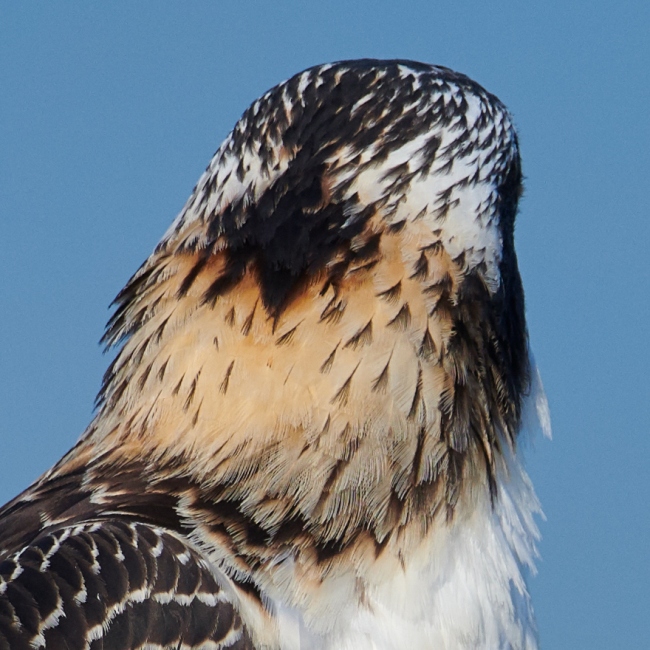
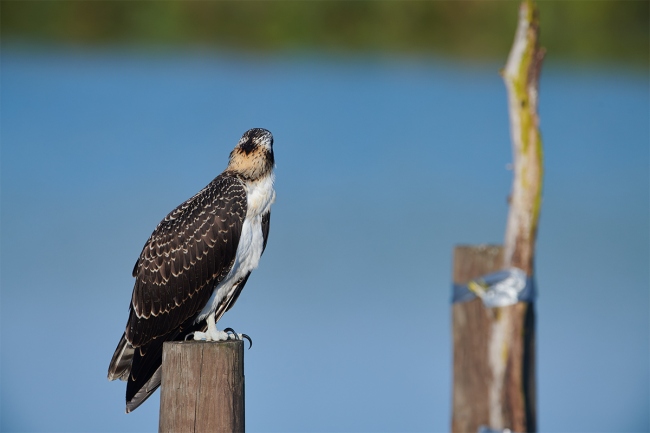
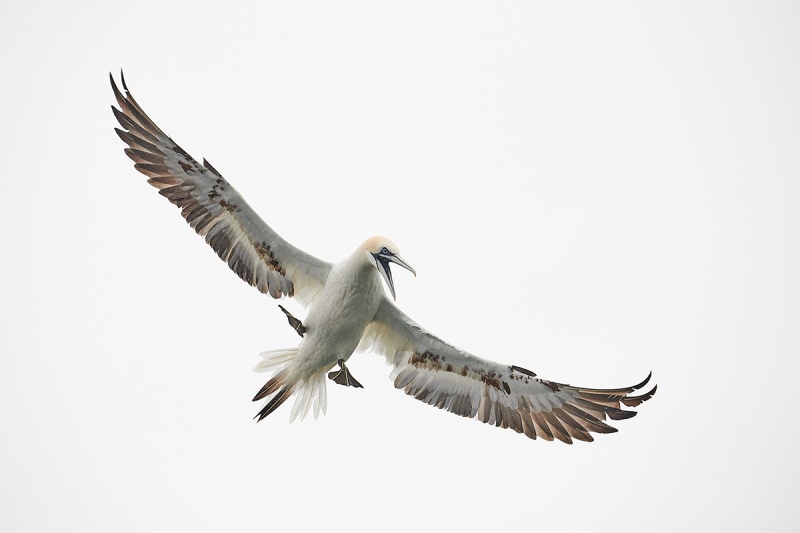
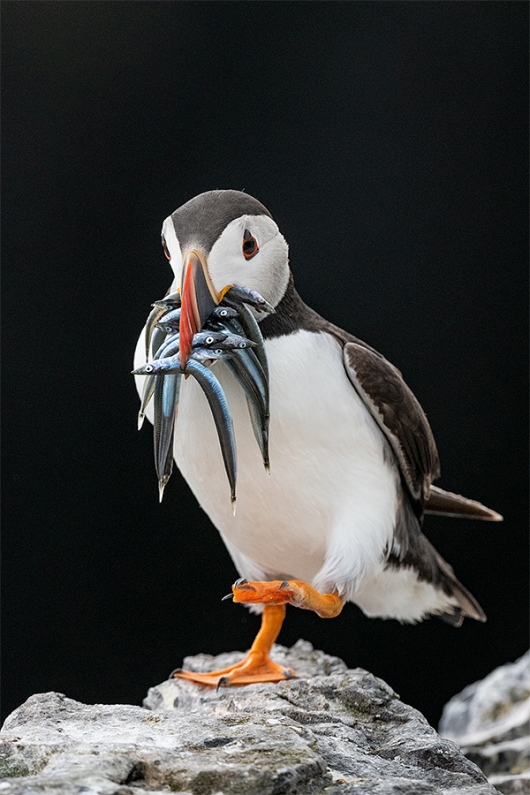
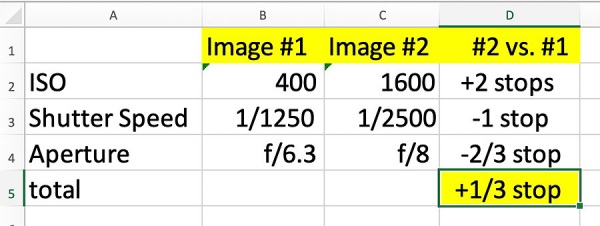
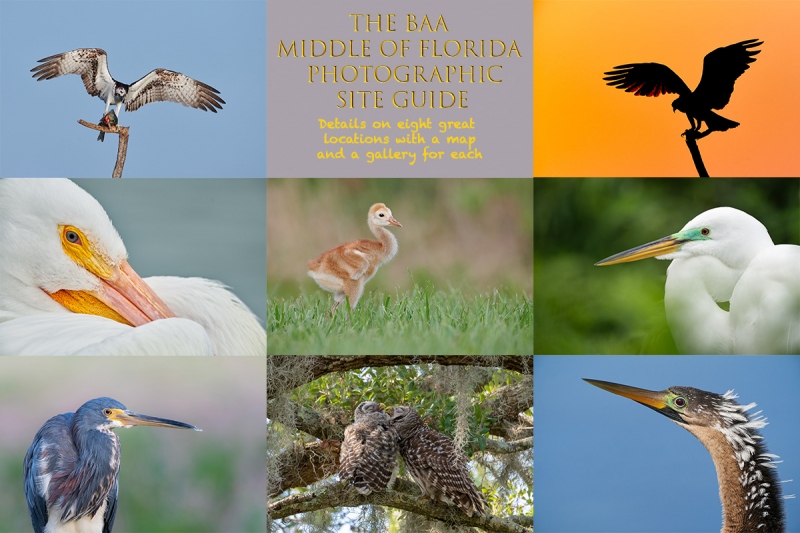













Sir, what about the -2/3 and -1/3 (-1/3) compensation compensation difference?
Exposure compensation difference I meant to write…
Another way of thinking about it :
ISO can be adjusted to determine how much light must be let in for a proper exposure but only the f-stop and shutter speed as well as level of ambient light will determine how much light hits the sensor
Artie,
On your exposure quiz … you asked which settings “let in the most light”?
I think there 3 factors which determine how many photons are let in:
1. The strength of the ambient light (how many photons are available per pixel)
2. The aperture setting
3. The shutter speed
I think ISO is an in camera amplification applied to the sensor as an after exposure adjustment and thus it does affect how much light comes into the camera.
Since it was not measured or specified I assumed ambient light was the same for the two
images in which case the slower shutter speed and wider aperture would certainly “let more light in”.